The Book Wraps Market is estimated to be valued at USD 1.4 billion in 2025 and is projected to reach USD 2.0 billion by 2035, registering a compound annual growth rate (CAGR) of 3.7% over the forecast period.
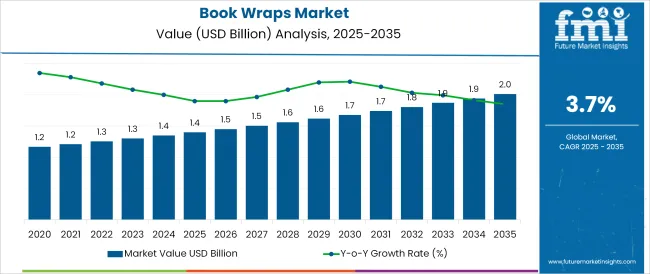
The book wraps market is undergoing notable growth as sustainability imperatives, e-commerce proliferation, and protective packaging standards converge to drive adoption. The increasing demand for damage resistant, lightweight, and cost efficient packaging solutions has positioned book wraps as an integral component in publishing and online retail industries.
Rising consumer expectations for intact deliveries, coupled with heightened brand focus on reducing returns and waste, have reinforced the importance of durable wraps. Market dynamics are further shaped by advancements in material sciences and manufacturing efficiency, which are enhancing performance and lowering production costs.
Future growth is anticipated to benefit from stricter regulatory focus on sustainable materials, innovations in recyclability and biodegradability, and expanding global reach of digital commerce. These factors are collectively paving the way for wider acceptance and deeper penetration of book wraps across diverse retail formats and geographies.
The market is segmented by Thickness, Material, and Product and region. By Thickness, the market is divided into 15-30 Microns, Up to 15 Microns, and Above 30 Microns. In terms of Material, the market is classified into Polyethylene, Polypropylene, Polyvinyl Chloride, Bio-based Plastics, and Other Materials. Based on Product, the market is segmented into Stretch Wrap and Shrink Wrap. Regionally, the market is classified into North America, Latin America, Western Europe, Eastern Europe, Balkan & Baltic Countries, Russia & Belarus, Central Asia, East Asia, South Asia & Pacific, and the Middle East & Africa.
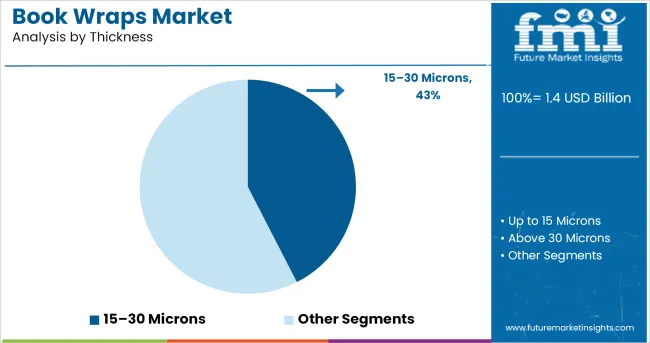
When segmented by thickness, the 15-30 microns category is projected to command 42.5% of the total market revenue in 2025, positioning it as the leading thickness segment. This leadership has been attributed to the optimal balance it offers between protection, flexibility, and cost efficiency.
Thinner wraps below this range often fail to provide sufficient tear resistance, while thicker variants tend to add unnecessary weight and material cost. The 15-30 microns segment has been increasingly preferred for its ability to withstand handling stresses during transit while maintaining a minimal material footprint.
Its suitability for high speed wrapping machinery and compliance with postal and courier standards have further reinforced its widespread adoption. The segment’s dominance has been solidified by its versatility across different book sizes and formats, enabling efficient inventory management for distributors and retailers.
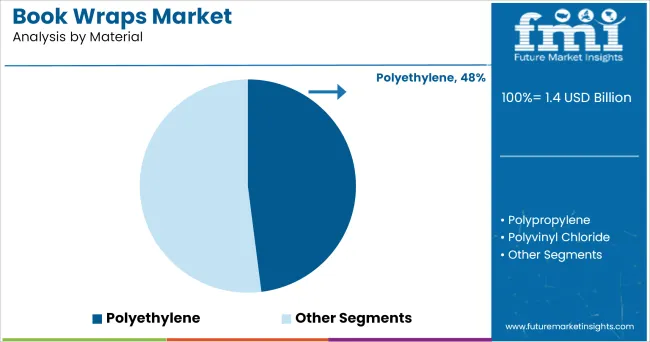
Segmented by material, polyethylene is expected to account for 48.0% of the book wraps market revenue in 2025, establishing itself as the leading material segment. This prominence has been sustained by polyethylene’s inherent properties of durability, moisture resistance, and ease of processing, which are critical for protecting books against environmental and mechanical damage.
The material’s cost effectiveness, coupled with its compatibility with both manual and automated wrapping techniques, has supported its widespread deployment. Additionally, ongoing innovations aimed at enhancing the recyclability of polyethylene have aligned with sustainability trends, enabling its continued preference over alternatives.
The ability to produce both low density and high density variants has allowed suppliers to tailor solutions to specific customer requirements, reinforcing polyethylene’s position as the material of choice in the market.
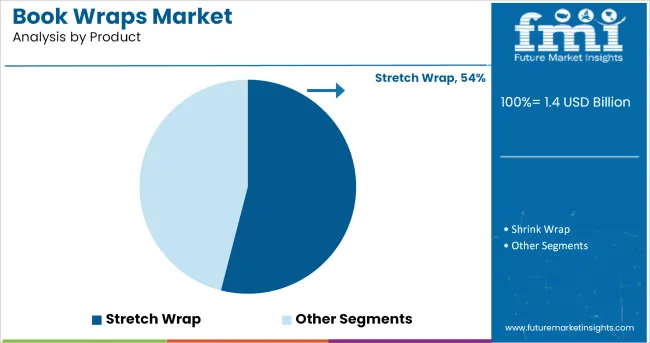
In terms of product type, stretch wrap is projected to hold 54.0% of the market revenue in 2025, making it the leading product segment. This dominance has been driven by the product’s capacity to provide secure, tamper evident packaging while accommodating varying book sizes and shapes.
Stretch wrap’s elasticity and cling properties have enabled efficient bundling and protection of books without the need for additional adhesives or fasteners. Its ability to deliver superior load stability during transportation and to minimize product movement has been a key factor in its widespread adoption.
Furthermore, stretch wrap’s compatibility with automated dispensers and its relatively low material consumption have enhanced operational efficiency for large scale distributors and retailers. The segment’s leadership has been reinforced by its role in optimizing packaging costs while ensuring that books reach customers in pristine condition.
During the historical period of 2020 to 2024, delivery wrapping boxes have been perceiving a significant rush in front of consumer doorsteps. In the USA, free shipping, faster delivery and more relaxed return policies have driven the demand for book wraps. For instance, in 2020, Amazon announced that they are growing their delivery service in one day to over more than 10 million products.
Rapid urbanization in developing regions, the rise in the international supply chain, the expansion of infrastructure facilities and the surge in per capita income are boosting worldwide demand. Corrugated wrapping is endorsing the rising demand owing to the benefits of grooved paper which can be recycled.
The increasing population and the demand for wrapping books are expected to rise due to the busy lifestyle of people. As cardboard wrapping keeps moisture away from the product and survives long shipping times, it is gradually being implemented by the manufacturers to offer better values to consumers, such factors are expected to drive the global demand for the product.
The E-commerce sector is the most essential segment in applications for book wraps due to the rise in the online shopping industry. The increasing demand for book wrapping boxes made from Kraft liners for the packaging of books ordered online is likely to excite over the forecast period.
Rising individual preferences for online shopping are major factors expected to drive sales over the forecast period. Additionally, online shopping offers advantages over retail shops, such as easy return policies, free shipping and faster delivery that has fueled the preferences for consumers towards online shopping, which in turn will result in growth in the demand of the product.
Moreover, the rising demand for cardboard material type of wrapping solutions across the customers, and manufacturers owing to growing concerns about the more safety of the product is projected to support the growth in the near future.
Many e-commerce companies are concentrating on defensive wrapping solutions in order to move towards paper-based wrapping and minimize plastic wastes. The trend is also projected to hit the book wrapping segment, which is sensitive to outer impacts with better design to make wrapping full-bodied.
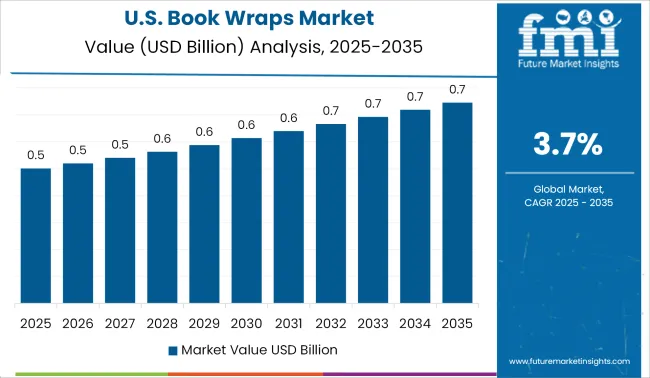
North America region is expected to hold a significant share in the book wraps market. The rising awareness among consumers regarding the convention of environment-friendly wrappings is anticipated to drive the demand for the book wraps in North America, over the forecast period.
The initiatives by regional governments for the usage of eco-friendly wrapping products, coupled with the efforts from the Corrugated Packaging Alliance (CPA), a wrapping industry initiative, with a purpose to inspire corrugated wrapping are providing an added stimulus to the growth of this region.
Furthermore, there has not been any regulatory or consumer pressure in the United States earlier for the recycling of cardboard, due to the low price of raw material used for making the target product. However, due to the growth of the e-commerce sector, the demand for cardboard is continuously rising, which, in turn, is creating a need for book-wrapping boxes.
Many major cities, like Massachusetts, Washington, New York, California and Maine have now banned the use of plastic bags and other single-use products which are non-recyclable that are harmful to the environment, in turn, boosting the demand for book wraps.
Asia Pacific region accounts for the maximum demand share in the global market. Whereas, China is the leading country on account of its high concentration of manufacturing units. Growth in the e-commerce sector is projected to benefit product manufacturers in the Asian region. Taiwan and South Korea are likely to showcase an increase in regional demand for book wraps on account of developments in the education sector.
Economies such as India, Indonesia and other developing Asian countries are expected to boost the overall regional demand due to the ongoing developments from end-use industries. Growth in population, high industrialization, emerging economies and the rise of units of manufacturing are the factors that should subsidize confidently to increase the regional share during the forecast period.

Some of the prominent players in the book wraps
These players hold the majority of the global share in the market. For instance, in 2024, Mondi Group had partnered with Mexican book wrap company, Cartro, to supply sustainable wrapping solutions for books and other products.
The leading manufacturers are aiming on developing countries that are projected to show potential for the development of the industry in the near future. It is essential for book wrap manufacturers to invest more in technology so as to automate the process of production. As the industries are slowly moving towards intensive capital, there is a need to achieve scale economically. It can be achieved by the divergence in various forms of wrapping
The report is a compilation of first-hand information, qualitative and quantitative assessment by industry analysts, inputs from industry experts and industry participants across the value chain.
The report provides in-depth analysis of parent market trends, macro-economic indicators and governing factors along with market attractiveness as per segments. The report also maps the qualitative impact of various market factors on market segments by box type, by size and by geographies.
The global book wraps market is estimated to be valued at USD 1.4 billion in 2025.
The market size for the book wraps market is projected to reach USD 2.0 billion by 2035.
The book wraps market is expected to grow at a 3.7% CAGR between 2025 and 2035.
The key product types in book wraps market are 15–30 microns, up to 15 microns and above 30 microns.
In terms of material, polyethylene segment to command 48.0% share in the book wraps market in 2025.






Full Research Suite comprises of:
Market outlook & trends analysis
Interviews & case studies
Strategic recommendations
Vendor profiles & capabilities analysis
5-year forecasts
8 regions and 60+ country-level data splits
Market segment data splits
12 months of continuous data updates
DELIVERED AS:
PDF EXCEL ONLINE
Industry Share & Competitive Positioning in Book Wraps Market
Booklet Label Market Size and Share Forecast Outlook 2025 to 2035
Book Marketing Software Market Size and Share Forecast Outlook 2025 to 2035
Book Binding Machines Market Size and Share Forecast Outlook 2025 to 2035
Bookends Market Insights - Trends & Forecast 2025 to 2035
Book Publishers Market Insights - Growth & Demand Forecast 2025 to 2035
Evaluating Booklet Label Market Share & Provider Insights
North America Booklet Label Market Growth – Trends & Forecast 2023-2033
Digital Publishing Revolution – Future of eBook Market Trends
Pre-book Airport Transfer Market Size and Share Forecast Outlook 2025 to 2035
Notebook Market Insights – Demand & Growth 2024-2034
Europe Booklet Label Market Segmentation by Material Type, Label Type, Printing Technology, End-Use and Region: A Forecast for 2025 and 2035
Thumb Hole Book Page Holder Market Size and Share Forecast Outlook 2025 to 2035
Online Airline Booking Platform Market Size and Share Forecast Outlook 2025 to 2035
Electronic Lab Notebook (ELN) Market Size and Share Forecast Outlook 2025 to 2035
Blunt Wraps Market Size and Share Forecast Outlook 2025 to 2035
Pallet Wraps Market Size and Share Forecast Outlook 2025 to 2035
Market Share Breakdown of Pallet Wraps Manufacturers
Coconut Wraps Market Outlook – Growth, Demand & Forecast 2025 to 2035
Sterile Wraps Market

Thank you!
You will receive an email from our Business Development Manager. Please be sure to check your SPAM/JUNK folder too.
Chat With
MaRIA